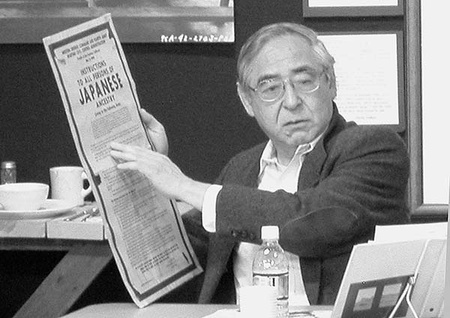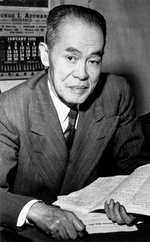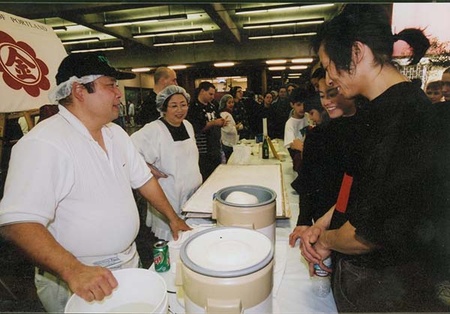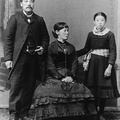Part 2 >>
Resettlement
At the end of the war, Japanese Americans had the difficult decision of where to go after they were released from the camps. In most cases, they had no businesses or homes to which to return. Often they faced the choice of returning to communities where they were clearly unwanted, or settling in areas unknown to them. Further limiting opportunities, the Oregon Legislature passed an amended, more restrictive Alien Land Law in 1945, prohibiting Issei from living or working on farmland. In 1949, however, Oregon became the first state to decide that the Alien Land Law violated the equal protection clause of the Fourteenth Amendment, and the law was repealed.
Some communities actively discouraged families from resettling. Anti-Japanese campaigning was especially active in Hood River well before evacuees were permitted to return. In a 1943 survey of Hood River residents, 84% said they did not want Japanese to return; 9% said they would allow only the return of citizens, 5% favored the return of Japanese, and 2% were undecided. Those families that did return could not buy groceries or do business at many local establishments. Although a few religious leaders and friends assisted in their resettlement, many years would pass before a state of normalcy returned to the area.
Only 40.3% of prewar residents of Hood River returned after the war, compared to 51.9 % in California and 40.2 % in Washington. About one-half of the Japanese from Portland returned to Portland. Housing discrimination forced many Japanese Americans into limited options. Many moved into Vanport, a 10,000-unit public housing project in North Portland that had been hastily assembled during the war to accommodate the thousands of wartime workers employed in Portland’s shipyards. A flood demolished the entire community in 1948, and residents of Vanport were confronted with starting all over. One of the Vanport residents, Iwao Oyama, had resumed publication of Oshu Nippo, using a mimeograph machine since his printing press confiscated by the U.S. government was never returned. The flood destroyed the mimeograph operation.
Nikkei Community Today
The majority of the original Japanese settlers and their children married exclusively within the Japanese community. Mixed marriages were not only frowned upon within Japanese culture; anti-miscegenation laws forbade marriages between “whites” and “non-whites.” After World War II, a number of Caucasian American servicemen brought Japanese brides with them to begin a new life stateside. As the third generation of Japanese American immigrants came of age, a much more significant movement towards intermarriage began, partly because Sansei were no longer living in exclusively Japanese neighborhoods. The Civil Rights movement of the 1960’s also brought an increased acceptance of interracial marriage.

Ed Miyakawa making presentation at a public program at Oregon Nikkei Legacy Center. Photo by Rich Iwasaki.
Our present Nikkei population is richly diverse. Our new sense of community is a delightful blend of many different cultures and races. As always, the Japanese sense of family remains strong—the definition has just been expanded.
Early Japanese immigrants to Oregon were quick to form associations with others from the same prefecture back home. Some of organizations formed 100 years ago continue in the Japanese American community today. The Japanese Association and kenjin kai that gave unity and supported the Issei generation became Nikkeijin Kai, or Japanese Ancestral Society. It continues as one of several focal points for Nikkei community life in the 21st Century.
With the development of global relationships between the State of Oregon and the Japanese government and corporations, the Nikkei profile has expanded to include Japanese who came to the United States after the Second World War. The descendants of the original Japanese settlers are coming from all parts of the continent and are bringing with them broader perspectives and life experiences. They, along with the newer members of the Nikkei community, are finding their places in Oregon Nikkei community life.

Visitors browse at ONLC Grand Opening Reception, September 2004, Merchant Hotel Building, Portland, Oregon. Photo by Rich Iwasaki.
The Japan-America Society of Oregon, formed in 1907 to foster business and cultural ties between Japan and Oregon, has developed the teaching program, Japan on the Road, to introduce contemporary Japan to Oregon elementary students. The Oregon Nikkei Legacy Center was created in 1998 to preserve and share the richness of Japanese American history. Through exhibits and outreach programs, ONLC brings the stories of Japanese Americans to the general public. The Portland Chapter of the Japanese American Citizens League, the oldest Asian American civil rights organization in the country, has recently become involved with the Arab American community as part of a commitment to address civil rights from a multicultural perspective. Portland Taiko was formed in 1994 by the Sansei and Yonsei Nikkei, and engages in energetic and creative ways to carry the message of Nikkei and Asian American identity. Shokookai of Portland supports Japanese business people and their families. This organization operates a Saturday Japanese School for the children of these families to help them keep up with their Japanese school curriculum.
Religious institutions such as Oregon Buddhist Temple, Nichiren Buddhist Temple, and Epworth United Methodist Church continue to serve. But each serves more diverse memberships. These institutions are joined by a number of more recently formed religious organizations.
© 2006 Oregon Nikkei Endowment







